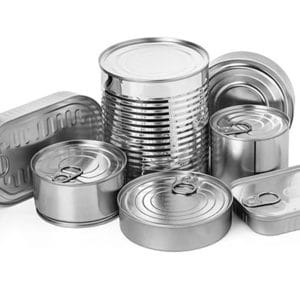Types of Packaging for Foods and Beverages

Cans
Some estimates suggest canned good account for up to 90% of some markets, although share is being lost to more modern forms of packaging. Cans have the following disadvantages:
- Expensive
- Heavy
- Empty cans occupy large storing rooms
- High manipulation costs
- Foods must be filled hot so there may be a loss of quality
Asepton Drum
Designed as a substitute for large 5 kg cans used in industry, this is a high tech drum made from cold rolled steel and lined with a food grade, PVC film. It is primary used for the packaging of liquid and semi liquid food products, like juices, pulps, purees and concentrates. It maintains the quality of the product and can be re-used several times once emptied.
Some of the disadvantages include:
- Expensive
- Foods must be filled in hot so there is big loss of quality
- Empty cans occupy large storing rooms
- Very difficult to be cooled once filled due to its dimensions
- High manipulation costs
Tetra Pak’s products
This kind of packaging is now well known in many markets and is particularly widespread in the milk, dairy and beverage industries. Similar competitor products are provided by other companies including PKL and International Paper. All such packaging has the following disadvantages:
- Not suitable for industrial volumes
- Products with fibres and particulates cannot be filled
Glass bottles, jars and PET
Glass is losing momentum in the market while PET is developing fast for the aseptic filling of juices and beverages.
Frozen foods
The freezing of foods enables the best quality products, but in some cases it is not a well established technology for industrial purposes. It also has the disadvantage that frozen products need dedicated storage and logistics.
Advantages of HRS’ Aseptic Technology
Combining specialist units such as HRS BP Piston Pumps, corrugated tube heat exchangers, the Unicus Series of scraped surface heat exchangers and the AF Series of aseptic fillers means that HRS can provide market leading technology for the aseptic processing of fruits and vegetables. Together they provide gentle handling of the product and efficient operation compared with comparable solutions.
Aseptic filling can be used for any type of fluid or doughy product processed by the food industry. In order to satisfy all requirements, producers of aseptic bags use various kinds of materials: high-barrier, multi-layer, flexible laminates, transparent or dull, coextruded, metalised of provided aluminium foils.
Bag-in-box & Bag-in-drum
There are different types and sizes of bags which are suitable for different applications.
- 55 gallon bags are available in metalized or coextruded materials and are usually associated with conical or cylindrical drums. Applications include traditional, delicate products such as tomato concentrate, paste and pulp, citrus fruits juice, fruit puree, diced tomato and diced fruit.
- Gusseted bags up to 220 litres can be adapted for use with various types of box, drum, or even bag. Modern bags guarantee an excellent barrier to oxygen, and are available in a variety of sizes from 5 to 220 litres. Applications include fruit juice concentrate.
- Large sized bags up to 1,000 litres have been developed with a particular focus on the practical handling, transport and storage of bulk foodstuffs.
Form-Fill-Seal (FFS) packaging
Form-Fill-Seal technology allows the production of finished packages which are filled, closed and labelled in a single process. The material for the packaging in supplied on a continuous reel and bags can be configured in multiple sizes from metalised or coextruded material.
These bags are suitable for filling various items from fresh fruits and vegetables to acid products (ketchup, pizza sauce, etc), fruit juices, dairy products (milk, cream, liquid egg, mayonnaise), pre-cooked foods, wine and vegetable oils.